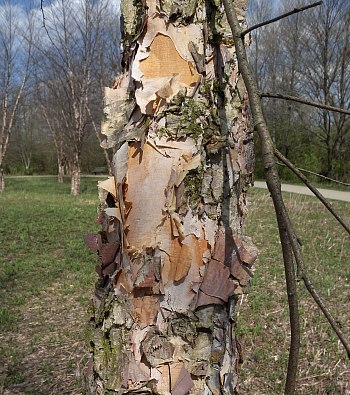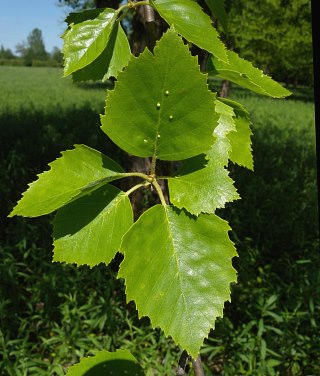Description: This tree is 40-90' at maturity, often forming a trunk that divides early and developing an irregular crown. The trunk bark of older mature trees is gray-brown and scaly, exfoliating only slightly, while the trunk bark of young trees exfoliates extensively, becoming ragged with patches of reddish brown, dull orange, or pinkish tan. The bark of branches and twigs is grayish brown and more smooth, while new shoots are light green and pubescent. The alternate leaves are 2-3" long and 1½–2¼" across; they are ovate-deltate in shape and doubly serrate along the middle to upper margins. Leaf bases are broadly wedge-shaped with smooth margins on either side of the petioles. The upper surface of the leaves is medium to dark green and glabrous, while the lower surface is either pale green, or whitish green and glaucous. Fine hairs are often present along the lower ribs of the central veins. The petioles are about ½" long and pubescent. The blooming period occurs during mid-spring as the leaves develop. Individual trees tree are monoecious with both male (staminate) and female (pistillate) flowers on separate catkins. Male catkins develop at the tips of twigs in clusters of 2-3; they are 2-3" long, reddish yellow, narrowly cylindrical in shape, and slightly drooping.

Individual male flowers are less than 1/8" (3 mm.) long,
each one consisting of a tiny calyx with 4 lobes and a pair of stamens.
In each
catkin, the male flowers are partially obscured by tiny bracts. Erect
female catkins develop from short spur twigs; they are ¾–1¼" long, ½"
across, narrowly ovoid in shape, and covered with fine hairs.
Individual female flowers are about 1/8" (3 mm.) long, each one
consisting of a
naked ovary with a pair of styles; neither a calyx nor petals are
present. The female flowers are partially obscured by 3-lobed bracts;
the narrow lobes of these bracts are nearly equal in size. The flowers
are cross-pollinated by the wind. Shortly afterwards, the female
catkins turn brown and develop a cone-like appearance, although they
remain non-woody. The winged seeds of these catkins mature during late
spring to early summer; they are distributed by either wind or water.
Individual seeds are broadly ovate, tapering to a slender beak (not
including the winged margins), and flattened. The root system is woody
and branching. This tree reproduces by reseeding itself.
Cultivation:
This tree prefers full or partial sun and moist conditions. It
tolerates various kinds of soil, including those containing loam, clay,
gravel, and silt. A very acid soil (pH 2-4) is tolerated surprising
well, while very alkaline soil (pH above 7) should be avoided. Seeds
should be planted while they are still fresh in moist soil and require
the presence of strong light to germinate. River Birch is more
resistant to Agrilus anxius (Bronze Birch Borer)
than most Betula spp. (Birch trees), which is a
major insect pest of these trees.

Range &
Habitat:
River Birch is occasional to locally common in southern and
west-central Illinois, while in the rest of the state it is uncommon or
absent (see Distribution
Map). Habitats include bottomland deciduous woodlands,
streambanks and low areas along rivers, drier areas of swamps, and acid
gravelly seeps. River Birch is a pioneer tree that typically colonizes
disturbed areas along rivers. Because of its tolerance of acidic soil
conditions, it has been used to reclaim the land of former strip mines
and it is often cultivated as a landscape tree.
Faunal Associations:
Many kinds of insects feed on various parts of River Birch and other Betula
spp. (birch trees), especially the caterpillars of many moths
(see Moth
Table). Other insect feeders include the caterpillars of the
butterfly Nymphalis antiopa (Mourning Cloak), the
larvae of sawflies, the grubs of wood-boring beetles, leaf beetles,
plant bugs, shield bugs, leafhoppers (Oncopsis spp.),
aphids, and others (see Insect Table for a listing of these
species). Among vertebrate animals, some species of birds eat the
seeds, buds, or catkins of birch trees; these species include the
Ruffed Grouse, Greater Prairie Chicken, Passenger Pigeon (now extinct),
Pine Siskin, White-Winged Crossbill, Purple Finch, and Black-Capped
Chickadee. The seeds are also eaten by the Red Squirrel. Beavers feed
on the wood and bark of River Birch, and they use its branches in the
construction of their dams and lodges. White-Tailed Deer browse on the
twigs and foliage, while the Cottontail Rabbit gnaws on the bark of
saplings and browses on the twigs and foliage of seedlings.

Photographic
Location:
Meadowbrook Park in Urbana, Illinois, and a city park in Champaign,
Illinois.
Comments:
The exfoliating bark of River Birch is very striking and unusual. While
other Betula spp. (Birch trees) have this
characteristic to a greater or lesser degree, their bark is more white
and less brown. River Birch also has the largest seeds of any Birch
tree within the state. It is possible, although a bit more tricky, to
identify this tree by the angular shape of its leaves: the lower
margins on either side of the petiole usually form an obtuse angle
(less than 180°) with straight sides, where they lack teeth. In
contrast, the leaf bases of other Birch trees are either truncate (flat
across) or more curved. Unlike other species in this genus, which are
more boreal and northern in their distribution, the range of River
Birch extends into many areas of southeastern United States.